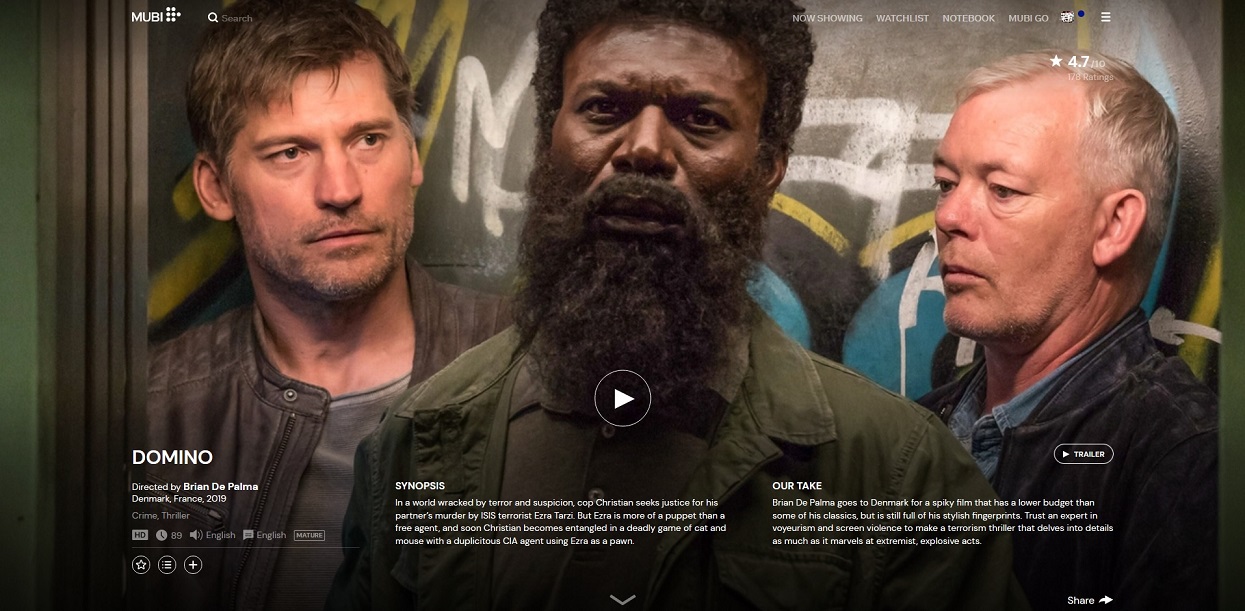
 Hello and welcome to the unofficial Brian De Palma website. Here is the latest news: |
|---|
E-mail
Geoffsongs@aol.com
-------------
Recent Headlines
a la Mod:
Listen to
Donaggio's full score
for Domino online
De Palma/Lehman
rapport at work
in Snakes
De Palma/Lehman
next novel is Terry
De Palma developing
Catch And Kill,
"a horror movie
based on real things
that have happened
in the news"
Supercut video
of De Palma's films
edited by Carl Rodrigue
Washington Post
review of Keesey book
-------------
Exclusive Passion
Interviews:
Brian De Palma
Karoline Herfurth
Leila Rozario
------------
------------
| « | September 2023 | » | ||||
| S | M | T | W | T | F | S |
| 1 | 2 | |||||
| 3 | 4 | 5 | 6 | 7 | 8 | 9 |
| 10 | 11 | 12 | 13 | 14 | 15 | 16 |
| 17 | 18 | 19 | 20 | 21 | 22 | 23 |
| 24 | 25 | 26 | 27 | 28 | 29 | 30 |
De Palma interviewed
in Paris 2002
De Palma discusses
The Black Dahlia 2006

Enthusiasms...
Alfred Hitchcock
The Master Of Suspense
Sergio Leone
and the Infield
Fly Rule
The Filmmaker Who
Came In From The Cold
Jim Emerson on
Greetings & Hi, Mom!
Scarface: Make Way
For The Bad Guy
Deborah Shelton
Official Web Site
Welcome to the
Offices of Death Records
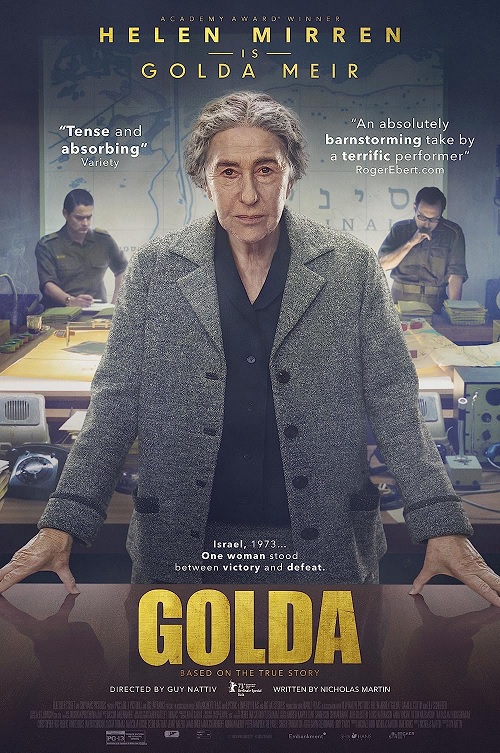
What did you want audiences to understand about Golda Meir that they may not have been aware of previously?Golda, in Israel, was basically a myth. She was maybe a statue, but no one put her name on schools or parks. She was kind of the pariah of Israel because her name was connected to the failure of the Yom Kippur War. It was kind of easy to blame an older woman from Milwaukee who didn’t know a lot about the war regarding what had happened. The Israeli generals did not take responsibility, did not say, “It’s on us.” She said, “It’s on me. I’m resigning.” And that’s the narrative that we grew up on, that Golda was a failure and it was a horrible war, but no one spoke about it. It was kind of a hidden secret until 10 years ago when declassified documents got out from the state and the truth came out that the actual intelligence division fucked it up. So, it wasn’t only her, that was the face of this failure. When I read the script by Nicholas Morton, I felt that we could do justice to this pioneer lady who was not perfect, and who was a controversial character, but she was not the only person whom we could blame for this war. So when I read the script, this was basically 80 percent war, 20 percent Golda. I pitched my idea to do the opposite, to let’s focus on Golda and let’s have 20 percent war. I wanted to do a war movie with not a single drop of blood.
In the film, the audience isn’t shown much of battle or the frontlines but we hear battlefield audio as it is presented to Golda. What was the thinking behind depicting the war in this way?
I grew up on The Conversation with Gene Hackman and Blow Out, the Brian De Palma film where there’s a recording of a murder. I also thought of The Lives of Others, where he creates a narrative through sound. I thought about how Golda experienced the war, which was only through sound because she couldn’t go to the front. So [I thought] why don’t we bring the war into the war room rather than just spend all our money shooting war scenes with tanks? So, I got from Amnon [Reshef], who was a commander in Battalion in the south. He owned all those recordings. I showed him the movie, and I asked him if he can give these [recordings] to us. I was blown away by the number of recordings from 1973. It made me cry and I did put it in a movie. What you hear, a big part of it, is real sound from the front.
Was it a difficult decision including the real audio? I know your father fought in the war. It is one thing to portray war; it’s another thing to portray the war with real audio. What made you decide that the audio should be in the movie?
The cinema today is so blended, you have documentary and narrative together. Look at Oliver Stone’s J.F.K. He used real footage from the assassination. I thought this would add to the authenticity. I asked the veterans what they thought about it, and they said that it’s an homage to the people who really gave their lives to the war. And when we screened the film in front of 6,000 people in Jerusalem with war veterans, they just were in tears and felt it was a beautiful homage. And we also dedicated this film to people who lost their lives in the war.
Mirren’s casting as Golda has been criticized given that she is not Jewish. What do you want critics to understand about your casting choice?
When I came to the project, Helen was already cast as Golda. Gideon Meir, Golda’s grandson, said to the producers, “I look at Helen, I see my grandmother. That’s who I want to play my grandmother.” When I came [on], they told me, you got the job why don’t you meet with Helen? She came to my house in the middle of the pandemic, and we sat and talked for three hours. She told me that when she was 29, she toured [Israel] and went to the kibbutz and volunteered and fell in love with an Israeli man. They toured the country, they hitchhiked and they were staying there for three-and-a-half months. She was more than just a visitor. When I spoke to her at my house, I felt that I’m speaking to my mom. I felt that she’s someone from my tribe. I felt that she was someone who understands the bits and pieces of what it means to be Jewish. So I felt that she’d be an amazing option to play Golda, other than the fact that she’s one of the best actresses of our time in our time. I respect the discussion. I think that CODA 30 years ago would probably be cast differently. And when I see CODA with people with hearing difficulties, it makes it much more authentic. And I think that Rain Man would probably not have Dustin Hoffman today, or Dallas Buyers Club would not have Jared Leto. So I’m open to that, but I personally thought that Helen is perfect for this to play Golda, especially after we got the blessing of the family.
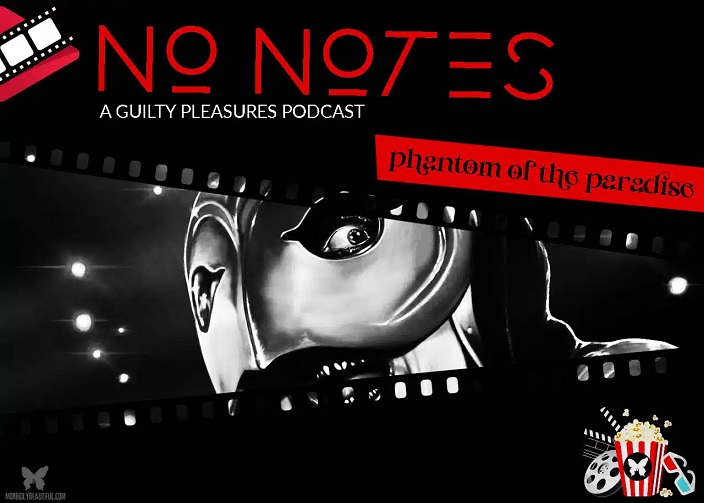
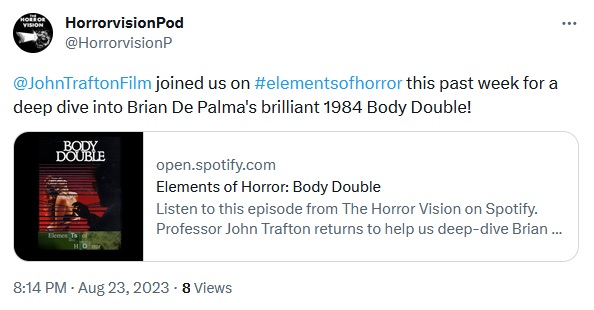
One of my favorite things is, you briefly mentioned that the movie kind of flips halfway through, and it’s like we get pulled into a different world. But there’s this one scene when he goes to Club X, when they’re doing that whole Relax song, where you see him and there’s that door labeled “Sluts,” and he’s standing there. The camera follows him, and we see the Holly character behind the swinging door. So the door is swinging, but we get glimpses of what she’s doing. The camera follows him in, but then everything goes neon, and you get the split-screen, where you’re watching her dance and you’re watching him watch her. And then when they close the door, she pulls him into her scene. And pulls him into her world. And everything turns upside down. And that’s probably my favorite part of the movie.
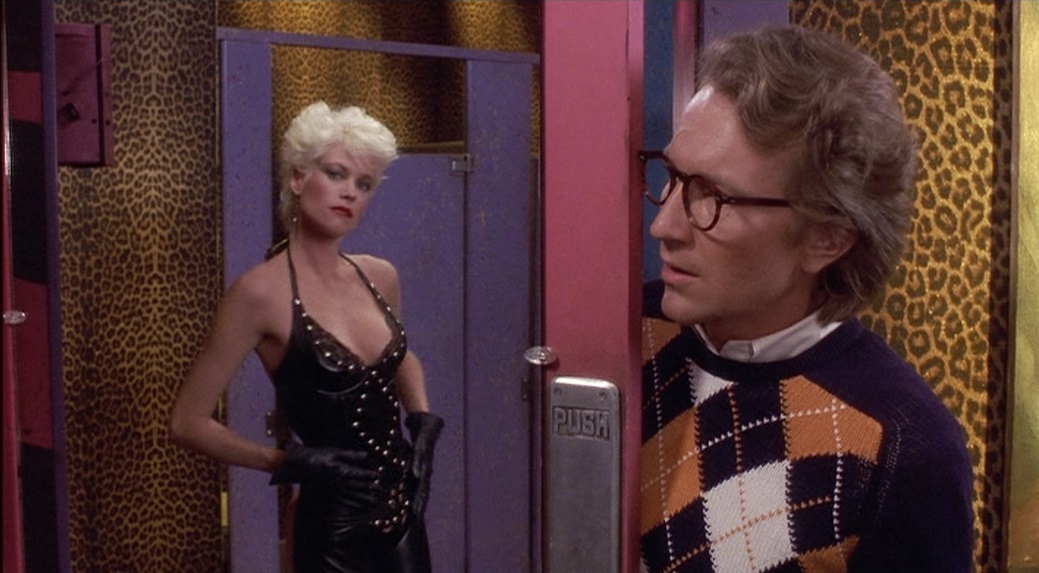
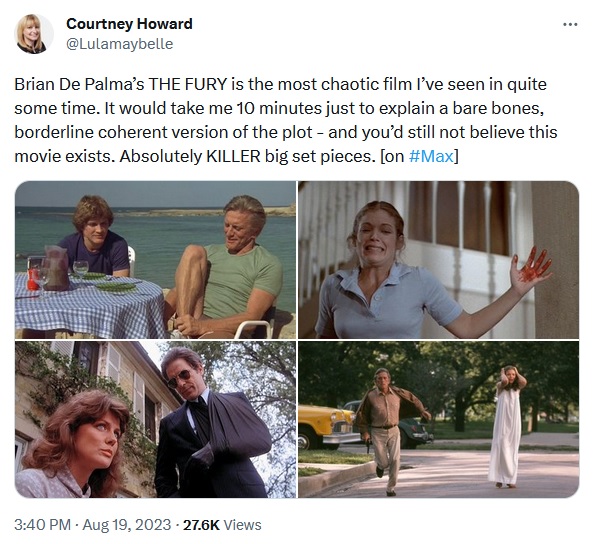
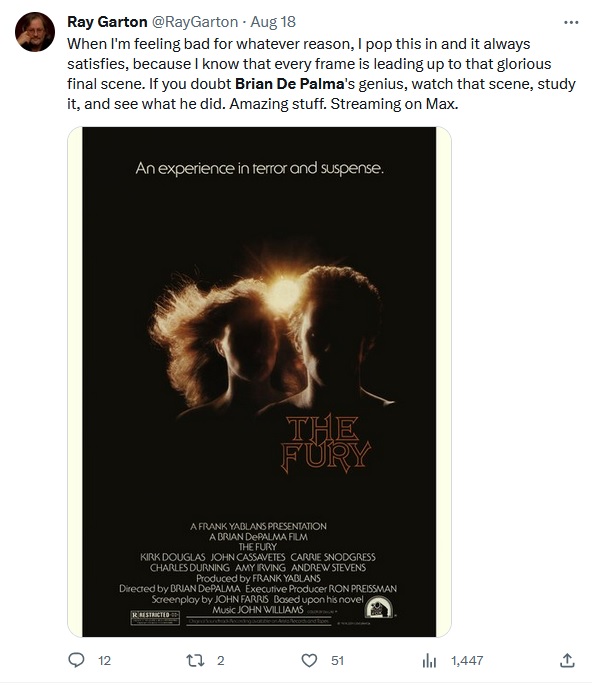
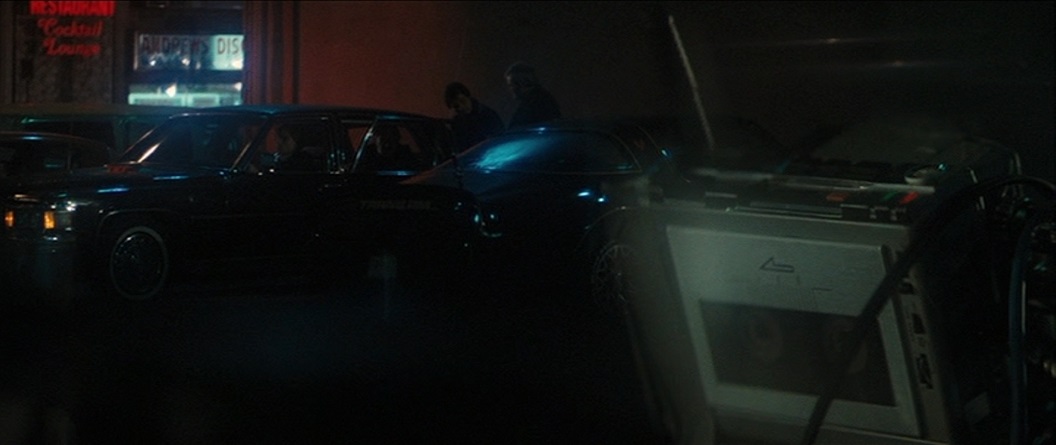
For today, Hugh has sent over a link to a review of The Enchanters, the new novel by James Ellroy. The review by Dan Piepenbring at Harper's Magazine includes mention of Blow Out:
As far as detectives go, Charlie Siringo walked so Freddy Otash could run, loot, and pop Dexedrine. He’s the Tinseltown private dick who narrates The Enchanters (Knopf, $30), James Ellroy’s lush, manic novelization of Marilyn Monroe’s death and all that was hushed up around it. The book contains more than a kernel of truth: Otash was a real fixer known for his A-list imbroglios and disreputable methods, including “cramming an unbelievable assortment of electronic gadgetry into an ordinary sound truck,” the Los Angeles Times wrote in 1971, describing what was then state-of-the-art surveillance. He met Ellroy a few times and bragged that he’d bugged Peter Lawford, JFK’s brother-in-law. He said he’d heard a tape of the president and Monroe having sex.Ellroy called Otash a “bullshitter,” and The Enchanters runs on his bullshit—it embroiders an embroiderer. At the outset, Jimmy Hoffa hires Otash to spy on Monroe, mere months before her overdose, and generate a scandal sheet about her misdeeds with the Kennedy boys. Snooping around her Brentwood hacienda, he finds too many loose ends: forty grand in cash, a wardrobe belonging to a much larger woman, a list of her lovers alongside the main switchboard number for the sheriff’s office. There’s also a Jackie Kennedy voodoo doll rife with pins, and a secret compartment containing “fuckee-suckee pix” coated in semen. Underbellies don’t come any seamier than this. From there, the plot is off to the sordid races.
Ellroy’s last novel, Widespread Panic (which also starred Otash), has been described as “camp noir.” The Enchanters continues along the same lines and throws some erotic fan fiction into the mix. “We’re all fan-club fools run amok,” Otash says of himself and his fellow Monroe obsessives. Like Brian De Palma in Blow Out, Ellroy goes in for loving close-ups on the tools of the eavesdropper’s trade, the phone taps and hidden bugs. But they can’t compete with “scent and sensation,” Otash says: “I wanted to touch things that touched her. I wanted to be where she got lonely and cut loose.” When Otash has a porny nightmare about his tradecraft, Ellroy’s rat-a-tat sleaze is pitch-perfect:
Wall wires, rug clamps, refitted phone jacks. They’re changing colors and starting to fray. They’re squirming. They’re untangling out in plain view.
They wiggle. Bore holes leak Spackle. Discolored Spackle—alive with a glow.?.?.?. Tap wires pop through handset perforations. Mike installations explode.?.?.?.
They’re moving. They’re pure combustion. They’re out to set me aflame.
The detective’s bag of tricks is all voyeurism, like Hollywood’s. The town that gave us the Western and the AR-15 was—is—overrun by profane megalomaniacs who had no business shaping the nation’s dream life, but did it anyway. Curious about the historical Otash, I dug up a fawning 1959 profile from the Los Angeles Mirror, which offered this choice detail: “The only item lacking to keep him from becoming a TV hero,” it reads, “is a gun strapped under his shoulder.” Riding high in his Cadillac Eldorado convertible, Otash had decided he didn’t need to carry one.
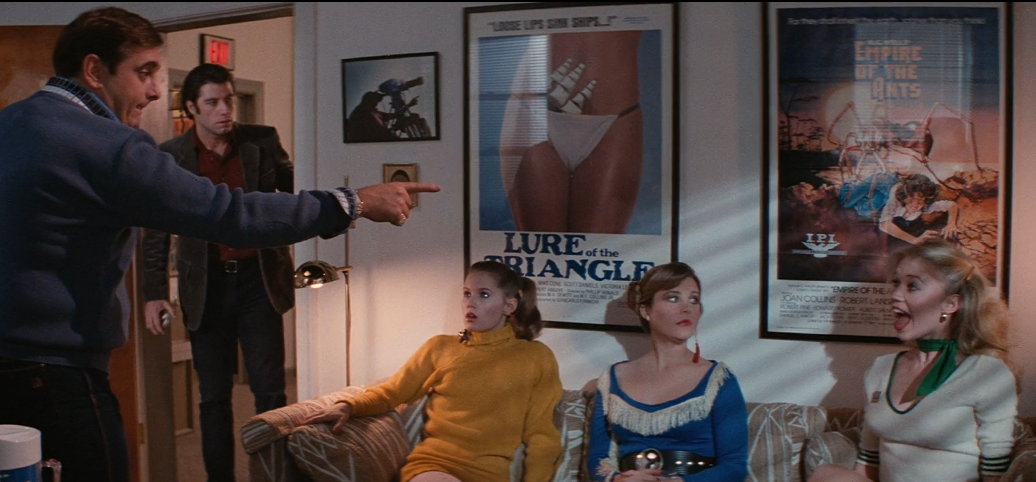
Ian Cooper, producer (“Nope”)
BLOW OUT (1981) — Working with Johnnie Burn on his epic and precise soundscape for NOPE (2022) had me recollecting on my introduction (and subsequent obsession) with movie sound design vis-a-vis De Palma’s foley-forward masterpiece. I watched this film on VHS in early high school and the boots-on-the-ground-artistry depiction of Travolta’s character concretized the marriage of pragmatism and creativity that is the bedrock of the BTS of filmmaking.
Blow Out/ Brazil – All systems rigged against the individual.
Blow-Out (1981)A perfect marriage of cinematic sound and image. Has any other film bridged the audiovisual divide better than this one? Split diopter shots, for example, visualize the process of eavesdropping. An eerily spinning shot disorients us while the sound becomes dizzying in its monotony. One of the post-Jazz Singer dreams is finally and gloriously realized: a film that uses sound and visuals interchangeably as brushstrokes on its cinematic canvas.
Scarface — A cultural phenomenon as much as it was a film. I remember seeing it opening night and thinking Pacino’s accent was so over-the-top. But then, as the film progressed, he just owned the screen in a performance that is so one-of-a-kind, it’s still jaw-dropping. Plus, Oliver Stone and Brian DePalma together? Insane.
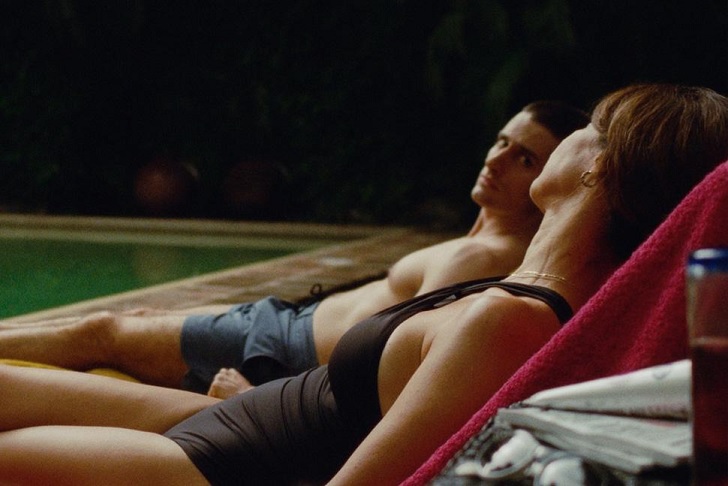
“This is the perfect New York story in that anything can happen,” Schnabel said. “That’s how it was growing up. You meet a complete stranger, you’re enamored or infatuated with them, and then two weeks later you realize they’re completely different.”Schnabel co-write the script with [Jack] Irv and Galen Core. Dark and handheld, Schnabel said he wanted to reference to the grit of ‘80s or ‘90s films to compliment the escalating trouble his boys find themselves in. The director sent an early cut of the movie to Martin Scorsese and prayed he would give feedback, only to have the icon come on board as an executive producer.
“I watched his films, Brian De Palma’s films, Cassavetes’ films, I thought that the movie was very grounded in other New York stories. When I heard that he liked it, I thought, okay, I might as well ask him and see what he says and he kindly he kindly accepted my offer. I’m forever grateful to even be associated with him.”
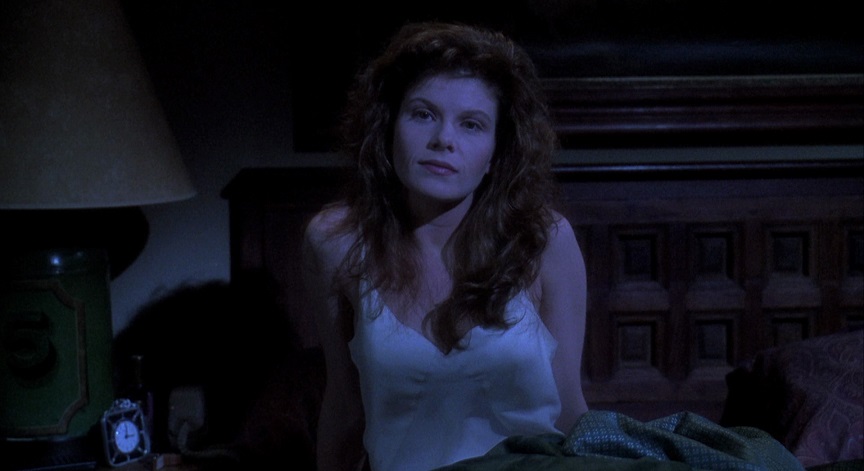

I am very happy that Peet Gelderblom was able to piece together a version of Raising Cain that followed the supposedly even more non-linear structure of De Palma's original screenplay. However, I have always loved the film for which De Palma brought in Paul Hirsch to help edit into gonzo shape, and that was originally released in theaters in 1992. Bloody Disgusting's Daniel Kurland seems to prefer Gelderblom's recut:
Brian De Palma is an absolute master visual storyteller and his movies are always cinematically stunning even when they don’t fully work as films. For every Carrie and Blow Out there’s a Snake Eyes and The Black Dahlia, but Snake Eyes still kicks off with a twelve-and-a-half minute unbroken tracking shot and Black Dahlia turns the camera into an airborne omniscient spectator during its dynamic gangland shootout and simultaneous corpse discovery. 1992’s Raising Cain comes at an important period of transition for De Palma. Sandwiched between The Bonfire of the Vanities and Carlito’s Way–ostensibly the two extremes of De Palma’s career–it’s easy for Raising Cain to get lost in the shuffle despite its completely gonzo nature and scenery-chomping performance from John Lithgow.Raising Cain is the story of Dr. Carter Nix (John Lithgow), a revered child psychologist who experiences a mental break and struggles to stay in control when other identities fight for authority. A hostage in his own body, Carter heads down a dark path that endangers his entire family while he relives his painful past. Raising Cain, for decades, was criticized for its confusing construction and was even viewed by some to be De Palma’s attempt at satire of his tried-and-true genre of choice. In reality, Raising Cain is an earnest–perhaps too earnest–movie that’s been misunderstood for a different reason altogether. Now, on its 31st anniversary, Raising Cain has become even more fascinating on a meta-narrative level. The film has turned into this bifurcated, jumbled experience that tries to messily reconcile many different ideas and tones at once through its two exceptionally distinct edits, like Carter’s own fractured psyche.
Seasoned De Palma fans will recognize how Raising Cain plays all of the director’s trademark hits, but those who aren’t already into De Palma’s style and aesthetic will have little to connect with in the heightened movie. It’s definitely a polarizing De Palma title, even for the hardcore fans, but Peet Gelderblom’s “director’s cut” edit does deliver a better version of this movie that creatively plays with non-linear storytelling. This might have been confusing in the early ‘90s, but audiences would learn to love this structural technique only a few years later with Pulp Fiction and Memento. It’s curious to consider how this avant-garde approach, if left undisturbed, might have come across as revolutionary rather than confusing, which was the fear. The theatrical cut attempts to bury, hide, and normalize these unique flairs–not unlike what’s done to Carter to smooth out his wrinkles so that he’s the most conventional, boring, mainstream version of himself. It’s another powerful, albeit unintentional meta element to Raising Cain that still rings true and makes the story behind the film and its two separate versions almost as interesting as the movie itself.
The divergent responses to the two cuts of Raising Cain emphasizes the “power of the edit.” The theatrical cut of Raising Cain, while chaotic, still led to a sect of audiences who believed that it’s meant to operate on dream logic and that it’s not supposed to make sense. The belief is that it’s ludicrous that De Palma has done so many better versions of this type of movie and that the audience knows that De Palma knows better. This dream logic rationale to Raising Cain’s theatrical cut may work, but it wasn’t De Palma’s original intention. Nevertheless, two complementary and contrasting movies can be born out of the same story, all depending on how it’s told and its dominant perspective. It would have been better if De Palma’s original vision could have made its way into theaters, but if any of his movies needs to suffer an identity crisis through its edit then it’s at least appropriate that it’s Raising Cain.
Raising Cain is dense with De Palma’s typical themes of dishonest women, overbearing fathers, and unhealthy familial relations between the three. It’s hard not to think of De Palma’s own frayed relationship with his doctor dad when Carter gets abused and mocked by his father, even if De Palma hasn’t acknowledged the connection between the two himself.
Raising Cain is hardly the first of De Palma’s movies to relitigate the same layered questions of identity that Alfred Hitchcock first unpacked in Psycho. Both Sisters and Dressed to Kill are De Palma’s previous attempts at dissociative identity disorder in one way or another, all of which are quite tone-deaf and ignorant on the material even if there seem to be good intentions. It’s important to understand that Raising Cain is very outdated when it comes to understanding Carter’s diagnosis. Raising Cain shouldn’t be viewed as an accurate, or even sensitive, portrayal of this condition. It’s a heightened boogeyman that operates in plain sight. Accordingly, there are shades of Dressed to Kill, Sisters, and Psycho in Raising Cain. The exceptional final shot also riffs on one of the scariest moments from Dario Argento’s Tenebre. However, more than anything, Raising Cain comes across as the synthesis between Body Double’s lurid thrills and Femme Fatale’s labyrinthine dream logic. Raising Cain is the messy stepping-stone between both of these more fully-formed movies that all riff on comparable themes.
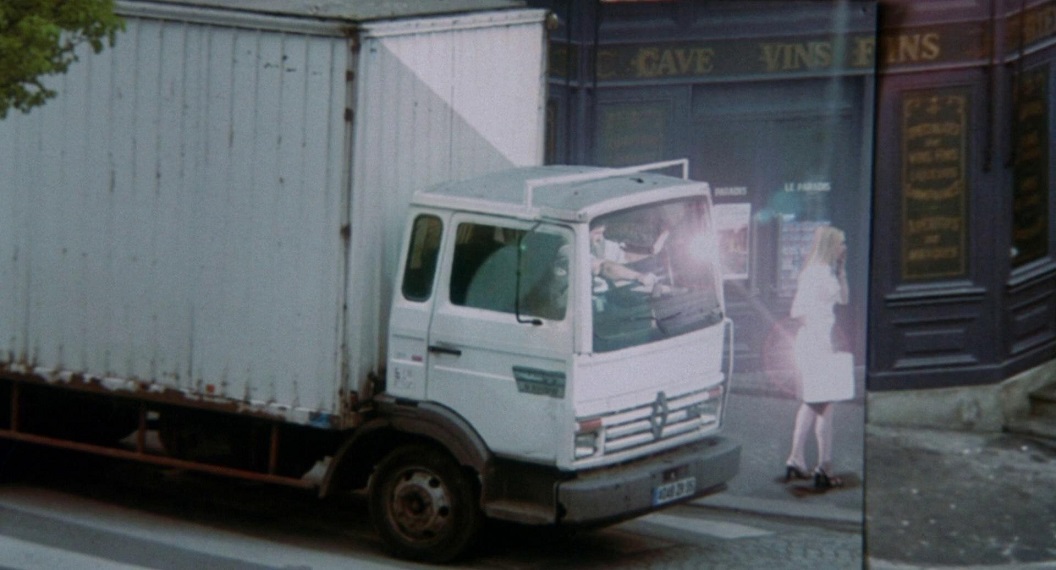
"But the sex and the silly serendipity are inextricable. De Palma turns visual pleasure—the luxurious vision of water pouring out of the bathtub; split screen shots showing the same scene from multiple angles so it becomes a cubist abstraction; the camera swooping up to look down into an interrogation room; the extreme close up of Laure’s eyes; multiple explicit sex scenes—into isolated fragments of anti-plot, which direct your gaze to a here that goes both everywhere and nowhere. Instead of trying to master visual pleasure with narrative, Femme Fatale revels in the way the femme fatale releases the film from sequence, logic, and ultimately even from misogyny. De Palma, that most faithful of Hitchcock disciples, tosses away narrative mastery, and with it the master's paranoia. What he's left with is a pleasure that, despite all the sex, feels so innocent you almost have to call it joy."
Here's a portion from the beginning of Berlatsky's essay:
Brian De Palma's Femme Fatale (2002) is a kind of inverse body double of his earlier film Body Double (1984). Both movies are obsessed with undermining, or castrating, the male gaze. Where Body Double frames the male viewer as impotent and frozen outside the narrative, though, Femme Fatale instead constructs a female viewer whose usurpation of the male position causes the film narrative to fragment into an eroticized stasis of fantasy and dream.The movie is ostensibly a noir in the tradition of Double Indemnity, which our seductress Laure (Rebecca Romijn) is watching (nude, her image superimposed on the screen within a screen) in the first scene. Laure is point person for a heist in which she is supposed to steal diamonds worn (or mostly not worn) by model Veronica (Rie Rasmussen) at a Cannes premiere. However, Laure double crosses her partners. Then things get odd.
Femme fatales in Hollywood cinema traditionally challenge the male dominance of look and plot. In her classic essay "Visual Pleasure and Narrative Cinema," Laura Mulvey argues that Hollywood films link male viewer and male protagonist as masterful gazers, whose look drives and orders the story arc. Women, in contrast, connote "to-be-looked-at-ness" they are "displayed as sexual object" and "erotic spectacle." The gaze possesses woman, which allows the (male) gazer in the theater the illusion of mastery. At the same time, though the spectacle of woman tends "to freeze the flow of action in moments of erotic contemplation." Woman is thus the prize of narrative mastery and a sensuous ice pick (or prick) in the eye of that same mastery. She is the prize that empowers narrative thrust and the twinkling treasure that leads the gaze (and other bits) off course.
Classic Hollywood films like Double Indemnity use the femme fatale to take advantage of this doubled gaze to heighten both impotence and empowerment. The erotic spectacle of Phyllis (Barbara Stanwyck) hijacks the male gaze and the male driven plot so that good guy Walter (Fred MacMurray) is diverted from the straight and narrow. Instead of his gaze driving the plot, her gazed-at-ness takes the wheel, steering him towards perversion, iniquity, and ultimately death. The film becomes a battle between the erotic distraction of the femme fatale and the righteous vision of the male. When Walter shakes off the glamour and does the right thing (by killing Phyllis) he reasserts his potency—though at the cost of his own life. That's the price of getting bogged down in the venus of spectacle.
Femme Fatale sort of reiterates this narrative tension, sort of parodies it, and sort of blows it up. Laure is an erotic spectacle which seizes control of the plot in numerous ways—first of all by literally seducing Veronica and ravishing her in the bathroom, pulling off her diamonds so her accomplice can slip substitutes under the stall. It's a flamboyantly queer literalization of the way that the femme fatale queers cinematic narratives.